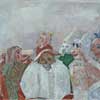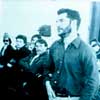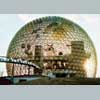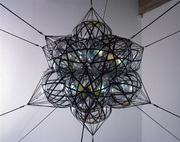 The hard gone soft, the raw cooked: This is the Claes Oldenburg we know and love, the Oldenburg of Soft Toilet, 1966, and Giant BLT (Bacon, Lettuce and Tomato Sandwich), 1963—shiny and tasty American wares fallen victim to gravity and deflation. But beginning in 1976, the artist’s collaborations with the late Coosje van Bruggen seemed to reverse course, stiffening into polished monumentality. While the Guggenheim and the National Gallery’s shared 1995 Oldenburg retrospective struggled to tie together these bodies of work, this survey leaves things largely bifurcated. Its first half, which includes rarely seen films, focuses on Oldenburg’s protean investigations of production, from The Store to soft sculptures to mid-’60s Happenings. Its second features his and van Bruggen’s little-known group of Brobdingnagian musical instruments, quite another take on collaboration
...
Read more »
|
 James Ensor (1860–1949), the Belgian Symbolist and proto-Expressionist, is a perennial favorite among people with the right taste. One of the very tippy-top paintings in any American collection is his—Christ’s Entry into Brussels in 1889, 1888, at the Getty. Sadly, that work will not travel here, although the show does feature the Museum of Modern Art’s no less iconic Masks Mocking Death, made the same year. Skeletons, masks, and puppets are mainstays of Ensorworld iconography, and yet for all his trafficking in lurid mayhem and morbidity, Ensor nevertheless suspires an air of transcendence. So we can thank MoMA for mounting this large-scale, thematically organized exhibition of approximately ninety paintings, drawings, and prints and for publishing a hefty, scholarly catalogue. At last, the heart sings, something worth looking at. |
 Since 1965, when he began producing the diagrams and photo-text magazine pieces that would become landmarks of Conceptual art, Dan Graham has made a series of swerves in his practice through video and film and performance to the architectural pavilions of the 1980s and beyond. This body of work—along with his early stint as a gallerist showing art by friends such as Carl Andre and Robert Smithson, and his energetic activities as a critic and speaker—has earned him near-legendary status. Artists today find a potent model in Graham’s integration of the conditions of exhibition and media reception into his own work; in his shape-shifting modus operandi; in his omnivorous cultural appetites. (His long-standing obsession with rock ’n’ roll, for instance, has given rise to extensive writings and the videos Minor Threat, 1983, and Rock My Religion, 1984.) And yet, due to
...
Read more »
|
 The atomic age is fading on its grainy analog newsreels, so it’s high time for the twenty-first century to place Buckminster Fuller in a romantically tinted retrospective. He’s quite an appealing figure, the space-age Thoreau, puffing like a summer breeze through the cold war. Until his thirties, Fuller was a gabby, overbright college dropout, a sometime meatpacker and sheet-metal worker with a Yankee tinker’s streak. Then bankruptcy and the death of a child provoked a mystical experience, a Whitmanesque self-reinvention in which “R. Buckminster Fuller” suddenly appeared in a Greenwich Village café as an autodidactic, self-appointed expert on everything. The danger signs of classic crankhood glow all over Fuller—for instance, he creates a tetrahedral “Dymaxion” geometry no one else can grasp—yet his mental breakthrough taps an awesome core of creative ener
...
Read more »
|
 Over the years, Cy Twombly has received few important museum exhibitions in the United States. New work has largely been seen only at Gagosian Gallery in New York, where it is shown for a month before disappearing into blue-chip private collections. So this exhibition of pieces made between 2000 and 2007, organized by James Rondeau with Twombly’s cooperation, marks a rare opportunity. It will include thirty-two works: photographs, drawings, sculptures, and large-scale paintings, all thematically related through subjects from nature. What should we expect to find? Having long since abandoned the many transgressions of his earlier work, Twombly—from the evidence we do have—is now conjuring paradise; the sheer luxuriance of his recent paintings surpasses even that of late Matisse. Of course, in these times, that may well prove to be the biggest transgression of all. |
 Known for his distinctively mischievous sense of humor as well as his incisive reconsideration of photography’s critical possibilities, Larry Johnson combines text, drawing, painting, graphic design, and animation within a photographic framework characterized by visual clarity, economy, and sharp focus. In Warholian fashion, Johnson often imbues his work with queer desire and dry melancholy as he mines lowbrow registers of American culture, resituating material drawn from such sources as People magazine, pulp fiction, celebrity auto-biographies, Hollywood histories, and advertisements. Sixty photographs made since 1982 feature in the Los Angeles–based artist’s first major survey exhibition in the United States, which is accompanied by a catalogue with essays by curator Russell Ferguson, Lee Edelman, and Esther Leslie, along with a reprint of a 1990 interview by Davi
...
Read more »
|
 Organized by LACMA and the Museum of Fine Arts, Houston, “Your Bright Future: 12 Contemporary Artists from Korea” features installations, sculptures, videos, computer animations, and Web-based work by artists born in South Korea between 1957 and 1972 and raised during a period of sustained political upheaval. Intended to redress what cocurator Lynn Zelevansky calls Korea’s “virtual absence from the Western imagination,” the show is accompanied by a catalogue with essays by Zelevansky, cocurator Christine Starkman, and art historian Joan Kee, as well as interviews with the artists and an informative time line of Korean art and politics from 1945 to the present. |
 A leading member of the Czech avant-garde in the 1920s and ’30s, cofounder of the Czech Photographic Society, and an influential teacher, Jaromír Funke (1896–1945) produced abstract still lifes and images of modern and classical architecture whose provocative play of shadows and forms invites comparisons to the work of Atget, Man Ray, Morandi, and Sheeler. Rather than highlighting these affinities, however, the first extensive show of Funke’s photographs outside Europe displays his lyric imagery alongside that of twenty-two of his compatriots, including Josef Sudek and Eugen Wiškovský. Some seventy works will contextualize this lesser known movement of self-taught photographers within the interwar explosion of avant-garde art. |
 Amy Blakemore’s photographs—of discarded shoes, gathering clouds, a child in a crowd—proffer open-ended narratives. That dreamlike opacity is augmented by her use of low-tech Diana cameras, which produce pictures with softly focused edges and blurred resolutions. The MFAH’s selection of thirty-six works from the past two decades—the artist’s first midcareer survey—tracks Blakemore’s transition from black-and-white to color, and considers how her casual snapshot aesthetic is married to a conceptual engagement with photography’s capacity to distort memory. The photographs are atmospheric in several senses: They capture a mood but also depict a hazy quality of light that feels related to the distinctively viscous air of Houston, where Blakemore has lived since 1985. A catalogue featuring essays by Alison de Lima Greene, Whitney curator Chrissie Iles, and others accomp
...
Read more »
|
 Pneumatic dreams hover over the work of Tomás Saraceno, just as they wafted through the hot-air balloons of the frères Montgolfier or the late-1960s inflatable architecture of the Utopie group. But if it seems that all we got from such techno-futurism was puffy IKEA chairs, Saraceno won’t let the bubble burst. His airborne structures and blow-up sculptures are actually prototypes for floating gardens or houses. Such constructions—along with photographs, drawings, and a new installation for the Walker’s terrace—are the focus of “Lighter than Air,” the artist's second solo US museum show (the first being at the Berkeley Art Museum/Pacific Film Archive in 2007). Other pieces in the exhibition, such as 59 steps to be on air by sun power/Do it yourself, 2003, a set of simple instructions for making a solar-powered balloon, are more Mad Max than Bucky Fuller—rerouting utop
...
Read more »
|
|
|
|
Statistics |
Total online: 1 Guests: 1 Users: 0 | |









